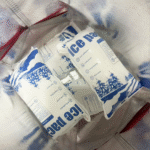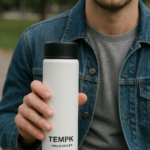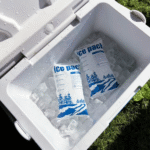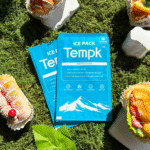What temperature are dry ice packs under real shipping conditions? At standard pressure, dry ice sits at −78.5 °C (−109.3 °F). In a shipper, internal air typically holds between about −70 °C and −20 °C depending on insulation, تنفيس, and pack placement. You’ll see why this range matters, how much dry ice to use, and how to stay compliant in 2025.

-
Exact numbers: what temperature are dry ice packs at the surface, in the box air, and at the product core
-
Sizing made simple: quick math for sublimation rates and a dry ice quantity estimator
-
Safer pack-outs: تنفيس, تسميات (UN1845), and spacing to prevent freeze damage
-
Smart choices: when dry ice beats gel/PCM—and when it doesn’t
-
الاتجاهات ل 2025: vent membranes, edge-aware loggers, CO₂ recovery, and digital DG workflows
What temperature are dry ice packs under real shipping conditions?
إجابة قصيرة: Dry ice is −78.5 °C at the source; box air stabilizes warmer (≈ −70 °C to −20 °C). Product core lags the air and stays below its spec if you size mass and insulation correctly. This is why what temperature are dry ice packs is a system question, not just a single number.
لماذا يهم: If you must hold ≤−18/−20 °C (بوظة, frozen desserts, some biologics), a −78.5 °C “cold battery” gives large safety headroom. For 2–8 °C, الجليد الجاف too cold—use gel or PCM to avoid accidental freezing.
How much dry ice to start with?
A practical daily estimator is:
الجليد الجاف (رطل) = (Transit hours ÷ 24) × Sublimation rate (lb/24 h)
Plan with typical rates by shipper quality and add a 10–30 % buffer for hand-offs and ambient spikes.
| Shipper Type | جودة العزل | Typical Sublimation (lb/24 h) | ماذا يعني لك |
|---|---|---|---|
| الرغوة EPS (≈ 2″ wall) | ممتاز | 4–6 | Great for 48–72 h lanes |
| Rigid plastic + بطانة | جيد | 6–8 | Balanced cost/hold |
| Corrugated + بطانة | معتدل | 8-10 | Add mass or shorten route |
| Pallet foam crate | غالي | 10-20 / البليت | Scale with openings and cube |
للنصيحة: It’s often cheaper to improve insulation than to keep adding dry ice. Better walls reduce loss across every touchpoint.
Pack placement patterns that actually work
-
Top-load only: المصارف الباردة; watch bottom warm-up on longer lanes
-
قمة + قاع: flatter gradients for mixed-density loads
-
Surround (الجانبين + قمة): most uniform profile; needs more initial mass
-
Interstitial (between layers): fast pull-down; add spacers for fragile packs
Real-world snapshot: A dessert brand cut temperature excursions by 38 % after switching from top-only blocks to a surround pellet pattern with the same mass.
What temperature are dry ice packs vs. gel and PCM packs?
خلاصة القول: Use dry ice for frozen (≤−20 °C). Use gel/PCM for 2–8 °C or CRT.
| Cooling Element | Set-Point / Behavior | أفضل استخدام | Watch-outs |
|---|---|---|---|
| الجليد الجاف (CO₂ UN1845) | −78.5 °C sublimes | Deep-frozen lanes | Venting required |
| حزمة هلام (0 درجة مئوية) | 0 °C melts | طعام مبرد | Short hold |
| PCM −21 °C | Phase at −21 °C | الأطعمة المجمدة | شرط مسبق |
| بي سي إم +5 درجة مئوية | Phase ≈ +5 درجة مئوية | اللقاحات | Avoid freezing |
| بي سي إم +22 درجة مئوية | Phase ≈ +22 درجة مئوية | CRT lanes | Needs insulation |
What temperature are dry ice packs at the product interface—and is it safe?
Contact risk: A −78.5 °C surface can freeze sensitive items on contact. Add a spacer (corrugate, foam tray) and distribute packs evenly.
قائمة مراجعة الامتثال
-
Proper name “Carbon dioxide, صلب (الجليد الجاف), UN1845 "
-
Net weight of dry ice on package
-
تنفيس (never airtight) حاوية
-
فصل 9 تسمية الخطر
-
Clear shipper / consignee info
| Topic | Essential Practice | What to Avoid | لماذا يهم |
|---|---|---|---|
| تنفيس | Use vent gaps | Airtight lids | يمنع تراكم الضغط |
| وضع العلامات | UN1845 + وزن + فصل 9 | Missing weights | قبول أسرع |
| التعامل | قفازات معزولة | Bare-hand contact | Avoids frost injury |
نصائح عملية
-
Door cycles: minimize openings
-
Logger location: near payload core
-
Lane design: prefer predictable curves, not perfect symmetry
How much dry ice do you need for 24–96 h lanes?
مثال: 48 h lane, الشاحن EPS, ≈ 5 رطل / 24 h →
(48 / 24) × 5 = 10 رطل + 10-20 % buffer → 11–12 lb total.
Validation beats theory—tune to your kit and lanes.
2025 trends in dry ice temperature control
Fresh in 2025: Smarter vent membranes, edge-aware loggers, CO₂ recapture, and digital DG workflows cut cost and emissions.
Highlights
-
Microporous vent lids stabilize internal air
-
Edge-aware loggers catch corner leaks early
-
Lower-carbon dry ice from CO₂ capture
-
Digital declarations reduce errors
نظرة السوق: Frozen DTC and biologics growth favors lighter, surround pack-outs with better insulation for cost control.
الأسئلة الشائعة
س 1: What temperature are dry ice packs at the start of a trip?
About −78.5 °C at surface/core; internal air warms to −70 °C to −20 °C depending on design.
Q2: Can I use dry ice for 2–8 °C?
لا. It’s too cold—use +5 °C PCM or gel packs.
س 3: Pellets or slabs?
Pellets distribute evenly; slabs last longer. Hybrid works best.
س 4: How close can dry ice be to my product?
تجنب الاتصال المباشر; use a spacer and rely on box air temp.
س 5: كم من الوقت يستمر الجليد الجاف?
Typically 18–96 h depending on insulation, كتلة, and ambient.
ملخص & التوصيات
النقاط الرئيسية: What temperature are dry ice packs = −78.5 °C source; box air warmer.
Use dry ice for frozen lanes, PCM/gel for 2–8 °C. Always vent, ملصق, and log.
الخطوات التالية:
-
Define target temp & lane time.
-
Choose correct coolant.
-
Estimate mass + 10-30 % المخزن المؤقت.
-
Use Top+Bottom or Surround layout.
-
Validate with loggers.
CTA: Ready to validate a −20 °C or −70 °C lane? Book a 10-minute pack-out review with Tempk.
حول Tempk
We design validated frozen, مبردة, and CRT pack-outs with proven insulation and accessories that hit −20 °C and −70 °C profiles reliably. Every design is backed by pilot data and SOPs that teams can follow easily.























